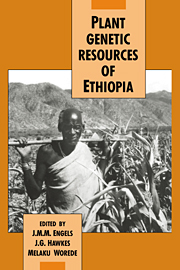Book contents
- Frontmatter
- Contents
- Contributors
- List of acronyms
- Preface
- Part I General introduction
- Part II The Ethiopian centre of diversity
- 2 The Ethiopian gene centre and its genetic diversity
- 3 Crops with wild relatives found in Ethiopia
- 4 Diversity of the Ethiopian flora
- 5 Forest genetic resources of Ethiopia
- 6 Plants as a primary source of drugs in the traditional health practices of Ethiopia
- 7 Traditional aromatic and perfume plants in central Ethiopia (a botanical and ethno-historical survey)
- 8 Spice germplasm in Ethiopia
- 9 A diversity study in Ethiopian barley
- 10 Sorghum history in relation to Ethiopia
- 11 Prehistoric Ethiopia and India: contacts through sorghum and millet genetic resources
- 12 Konso agriculture and its plant genetic resources
- Part III Germplasm collection and conservation in Ethiopia
- Part IV Evaluation and utilization of Ethiopian genetic resources
- Index
3 - Crops with wild relatives found in Ethiopia
Published online by Cambridge University Press: 30 October 2009
- Frontmatter
- Contents
- Contributors
- List of acronyms
- Preface
- Part I General introduction
- Part II The Ethiopian centre of diversity
- 2 The Ethiopian gene centre and its genetic diversity
- 3 Crops with wild relatives found in Ethiopia
- 4 Diversity of the Ethiopian flora
- 5 Forest genetic resources of Ethiopia
- 6 Plants as a primary source of drugs in the traditional health practices of Ethiopia
- 7 Traditional aromatic and perfume plants in central Ethiopia (a botanical and ethno-historical survey)
- 8 Spice germplasm in Ethiopia
- 9 A diversity study in Ethiopian barley
- 10 Sorghum history in relation to Ethiopia
- 11 Prehistoric Ethiopia and India: contacts through sorghum and millet genetic resources
- 12 Konso agriculture and its plant genetic resources
- Part III Germplasm collection and conservation in Ethiopia
- Part IV Evaluation and utilization of Ethiopian genetic resources
- Index
Summary
Introduction
All our modern crops have been developed from wild plants. The domestication of a plant passes through stages from intensified usage of the wild plant to the development of a domesticate so dependent on Man that it cannot survive in the wild. All stages are seen in the crop complement of Ethiopia. There are many wild plants which are used for food, particularly in times of food shortage such as the period between seed sowing and harvest. It is hardly surprising that the majority of such plants are those used as leafy vegetables, followed by those with edible fruits, tubers or roots. Another example is the grass, Snowdenia polystachya (Fresen.) Pilg., whose seeds are collected and used in a similar way to teff. The following account includes only those that are related to domesticates. Examples of semi-domesticated plants are Avena abyssinica and Coccinia abyssinica, both of which are discussed further below. There are also wild plants now attracting attention as potential crops, for example Vernonia galamensis (Cass.) Less. (Perdue, 1988) and Cordeauxia edulis (Hemsl.) (Polhill & Thulin, 1989). Ethiopia also has fully domesticated endemic crops, the best known being teff, Eragrostis tef and ensete, Ensete ventricosum. For fully domesticated plants the wild species from which the crop developed has in some cases been identified; in others it seems to have disappeared after the plant was domesticated.
Both environmental degradation and modern agriculture are putting traditional crops and their wild relatives at risk.
- Type
- Chapter
- Information
- Plant Genetic Resources of Ethiopia , pp. 42 - 74Publisher: Cambridge University PressPrint publication year: 1991
- 18
- Cited by



